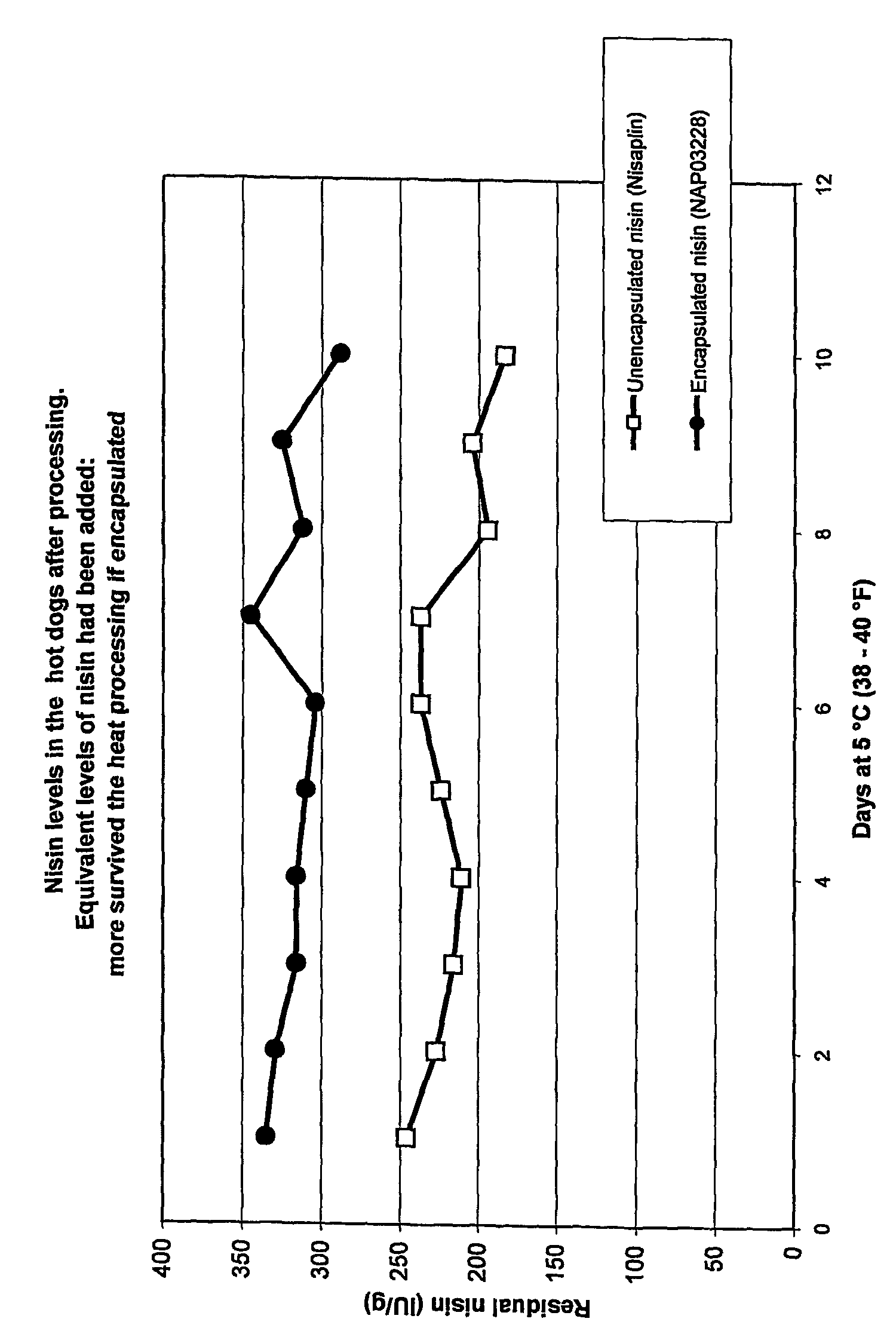Encapsulated antimicrobial material
a technology of antimicrobial material and encapsulation, which is applied in the direction of milk preservation, application, meat/fish preservation by coating, etc., can solve the problems of high pressure and yield stress on the material, and achieve the effect of facilitating the stability or activity of the antimicrobial material, high pressure and yield stress
- Summary
- Abstract
- Description
- Claims
- Application Information
AI Technical Summary
Benefits of technology
Problems solved by technology
Method used
Image
Examples
example 1
[0384]First, a solution of 15 g k-carrageenan in 1000 mL of phosphate buffer at pH 3.5 is prepared at 85° C. To this is added 300 g of Nisaplin® (Danisco commercial extract of nisin: equivalent to 1×106 IU / g nisin potency). The resulting mixture is thoroughly mixed. At the same time, a mixture of 1333 g of a vegetable triglyceride (Danisco: GRINSTED® PS 101, m.p. 58° C.) and 73 g of acetylated emulsifier (Danisco: Acetem 50 00) is melted at 85° C. in a water bath. The melted fat mixture is kept under homogenisation (Silverson mixer, 8 kRPM) as the aqueous mixture is slowly incorporated. The homogenisation is maintained for 5 minutes after the whole aqueous mixture is added and then a solution of 3 g of polysorbate 80 in 40 mL of water is added under constant mixing. The resulting low-viscosity water-in-oil emulsion is then immediately spray cooled in a Niro spray tower using the following parameters: inlet air temperature: 10° C., outlet air temperature 28° C., rotating atomization ...
example 2
[0387]First, a solution of 15 g sodium alginate in 1000 mL of phosphate buffer at pH 3.5 is prepared at 85° C. To this is added 300 g of Nisaplin® (Danisco commercial extract of nisin: equivalent to 1×106 IU / g nisin potency). The resulting mixture is thoroughly mixed. At the same time, a mixture of 1333 g of a vegetable triglyceride (Danisco: GRINSTED® PS 101, melting point 58° C.) and 73 g of acetylated emulsifier (Danisco: Acetem 50 00) is melted at 85° C. in a water bath. The melted fat mixture is kept under homogenization (Silverson mixer, 8 kRPM) as the aqueous mixture is slowly incorporated. Following the incorporation of the aqueous mixture, a solution of 7 g of calcium chloride in 70 mL of water is added dropwise. The homogenization is maintained for another 5 minutes and then a solution of 3 g of polysorbate 80 in 40 mL of water is added under constant mixing. The resulting low-viscosity water-in-oil emulsion is then immediately spray cooled in a Niro spray tower using the ...
example 3
[0389]A solution of 1 g of a bilayer-forming lipid and 100 mg of cholesterol in a suitable organic solvent is evaporated so as to form a thin dry lipid film on the bottom of the container. After thorough drying of the lipid film, 1 L of water containing nisin (as Nisaplin®) at the saturation concentration is added to the container and the mixture is thoroughly mixed or homogenized. The resulting suspension of multilamellar vesicle (MLV) can be further processed by microfluidization to form smaller more homogenous small unilamellar vesicle (SUV). The suspension of liposome-encapsulated nisin can be added directly to the meat by injection / tumbling.
[0390]These particles are small enough to pass through injection needles without disintegration of the liposome shell. The liposome-encapsulated nisin would be released on cooking since liposomes break up at 45-50° C. because of the transition temperature of bilayer-forming phospholipids / amphiphilic compounds. Lipsome-encapsulated nisin woul...
PUM
| Property | Measurement | Unit |
|---|---|---|
| temperature | aaaaa | aaaaa |
| melting point | aaaaa | aaaaa |
| pressure | aaaaa | aaaaa |
Abstract
Description
Claims
Application Information
 Login to View More
Login to View More - R&D
- Intellectual Property
- Life Sciences
- Materials
- Tech Scout
- Unparalleled Data Quality
- Higher Quality Content
- 60% Fewer Hallucinations
Browse by: Latest US Patents, China's latest patents, Technical Efficacy Thesaurus, Application Domain, Technology Topic, Popular Technical Reports.
© 2025 PatSnap. All rights reserved.Legal|Privacy policy|Modern Slavery Act Transparency Statement|Sitemap|About US| Contact US: help@patsnap.com

